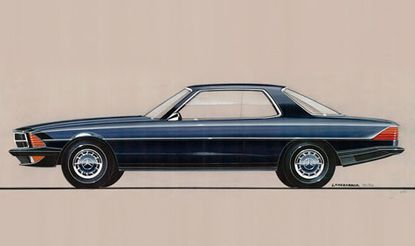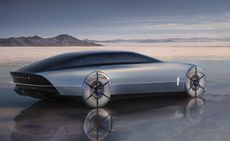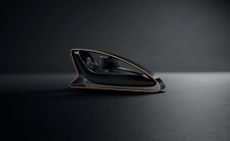Mercedes-Benz: A Design History

Somewhat unfairly, Mercedes-Benz has never garnered the designer laurels of their immediate competitors. Although the company – the oldest automotive brand in the world - has done more than any other to shape the form of the automobile, Mercedes has always seemed content to let other firms present their work as 'design-led'.
It's only in the past decade, in a car market defined by the dark art of branding and an unprecedented proliferation of products, that the German firm has been more vocal about the processes and practices that shapes their range.

See more of Mercedes-Benz over the years
So what defines Mercedes-Benz design? Like all car makers, Mercedes-Benz likes to talk genetics, implying that car design is akin to raw evolution, a survival of the fittest ethos where only the best expressions of the brand make it to market.
DESIGN, a monograph intended for internal consumption only, is rich with intriguing prototypes and concepts, some of which demonstrate their place is this most ordered of families, others representing a more distant future or even blind alleys that were never pursued.
While there are welcome glimpses of the earliest cars produced by the company, as well as the impressive set of autobahn stormers conceived during the 1930s, our eyes are drawn to the svelte concepts and research cars. These demonstrate a company always looking to push the technological boundaries, if not the aesthetic ones (although some, like the gullwinged C111 supercar, do both with aplomb).
Mercedes' key reputation rests on its saloon cars, traditionally deemed to hide over-engineered excellence beneath sober surfaces and straitlaced proportions. Sometimes this resulted in a brutal, bombastic simplicity, like the mighty 600 Pullman limousine of the 60s. Yet the company has also led the way in sports car design, with the fabulous race cars of the post-war era spawning the 300SL, a fabulous creation that is a direct ancestor of today's SL range.
Wallpaper* Newsletter
Receive our daily digest of inspiration, escapism and design stories from around the world direct to your inbox
After being overseen by Peter Pfeiffer for the bulk of the 21st century (Pfeiffer worked for Mercedes-Benz for over forty years in all), the company's design studio is now led by Gorden Wagener. The modern Mercedes-Benz is a rather more muscular creation, aimed at consumers who have largely abandoned discretion in favour of stylish statements about their own personal tastes and desires.
With the emergence of new propulsions systems and shifting consumer attitudes to cars in general, automotive design language is entering a new era. As the company that effectively kick-started the industry, we imagine Mercedes-Benz will want to play a key part in keeping it alive in the future.
Jonathan Bell has written for Wallpaper* magazine since 1999, covering everything from architecture and transport design to books, tech and graphic design. He is now the magazine’s Transport and Technology Editor. Jonathan has written and edited 15 books, including Concept Car Design, 21st Century House, and The New Modern House. He is also the host of Wallpaper’s first podcast.
-
 DAB 1α electric motorbike is the first product from French manufacturer DAB Motors
DAB 1α electric motorbike is the first product from French manufacturer DAB MotorsThe DAB 1α is an all-electric motorbike born out of industrial design, gaming culture and aviation technology, and now available to order
By Jonathan Bell Published
-
 The 2024 Ivor Novello nominations for songwriting have been revealed
The 2024 Ivor Novello nominations for songwriting have been revealed77 British and Irish songwriters and composers make up this year's nominees, announced tonight at London's Groucho Club
By Charlotte Gunn Published
-
 Why Bollinger’s La Grande Année 2015 champagne is worth celebrating
Why Bollinger’s La Grande Année 2015 champagne is worth celebratingChampagne Bollinger unveils La Grande Année 2015 and La Grande Année Rosé 2015, two outstanding cuvées from an exceptional year in wine-making
By Melina Keays Published
-
 Peugeot’s sparky 308 gets hybrid power and handsome lines
Peugeot’s sparky 308 gets hybrid power and handsome linesThe Peugeot 308 proves that mass-market design needn’t be dull, blending hybrid power with sharp lines and excellent detailing
By Jonathan Bell Published
-
 BMW Motorrad brings out the big guns for its newest cruisers
BMW Motorrad brings out the big guns for its newest cruisersBMW Motorrad R 18 Bagger and Transcontinental set the tone for high-voltage cruising with a brand collaboration with speaker specialist Marshall
By George Chapman Last updated
-
 Dacia’s new Manifesto concept is a true outdoor utility vehicle
Dacia’s new Manifesto concept is a true outdoor utility vehicleUtilitarian auto brand Dacia sets a bold new agenda with its Manifesto, a concept car pitched at the active outdoor market
By Jonathan Bell Last updated
-
 The sun sets on traditional supercars at California’s Monterey Car Week
The sun sets on traditional supercars at California’s Monterey Car WeekMonterey Car Week, the world’s most prestigious car gathering, is showcasing ever-more extravagant special editions, coachbuilt cars and all-new electric concepts. Here are seven key machines from 2022
By Rory FH Smith Last updated
-
 Is McLaren’s GT a sports car, a tourer, or the best of both?
Is McLaren’s GT a sports car, a tourer, or the best of both?The McLaren GT is a capable all-rounder dressed up in svelte supercar clothes. It might also be the last of its type
By Jonathan Bell Last updated
-
 Rolls-Royce puts the Phantom back on its lofty pedestal
Rolls-Royce puts the Phantom back on its lofty pedestalA mid-life refresh ensures the flagship Rolls-Royce Phantom Series II is at the top of its game, a last hurrah for traditional engines before an electrified future
By Jonathan Bell Published
-
 Prodrive’s new racing simulator is shaped by Callum to be front of the grid
Prodrive’s new racing simulator is shaped by Callum to be front of the gridThe racing simulator shapes up – this new design from Prodrive and Callum is honed for the high-end games room
By Jonathan Bell Last updated
-
 928 by Nardone Automotive: a restomod Porsche with Gallic verve and Italian style
928 by Nardone Automotive: a restomod Porsche with Gallic verve and Italian style928 by Nardone Automotive is a gracefully modernised version of Porsche’s endearingly different 928
By Jonathan Bell Last updated